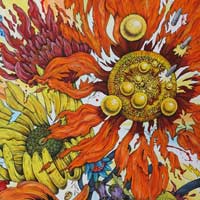Two Artists Tackle the Lost World of Plants
Penelope Gottlieb and Cynthia James Paint Extinct Plant Species
Two shows now on view at relatively new spaces share an interest in the ways that plant life can reflect the deep time in which our historical consciousness as a species occupies such a brief interval. The heavy burden of responsibility that humans bear for the planet’s current phase of environmental decline—the so-called sixth period of mass extinction—has resulted in an extraordinary sense of urgency in the way these two artists have reinvigorated the art of illustration that they inherit from John James Audubon and others.
Penelope Gottlieb’s is titled Gone: A Visual Eulogy for Lost Plant Life, and it covers the walls in Madame Ganna Walska’s former residence on the grounds of Lotusland. Gone is the first art exhibit staged in the space, and it makes a terrific complement to what’s already on offer at the world-famous garden. Gottlieb has had a kind of “Eureka!” moment with this chapter in her evolution as an artist, and the work is among the strongest I’ve seen from any Santa Barbara artist since arriving here in 2001. There’s a devastating clarity of vision and immediacy to the fusion she’s achieved, which combines the decorative, the illustrative, and the figurative in a new, beautiful, and intensely provocative manner. Beginning with either illustrations or, in some instances, just verbal descriptions of extinct plant species, Gottlieb has created dazzling canvases, some quite large (up to 84 by 66 inches) that portray these specimens in the process of, for lack of a better word, exploding. Although she sometimes employs the fizzy visual rhetoric of comic book action in order to convey movement, the ripping, shredding tension of these works typically comes about through devices of composition. Huge blossoms and fruit bulge toward the surface, yielding tattered petals and even, in some cases, traces of blood. Beneath the botanical surface of each image lie myriad clues to the environmental disasters that led to the plants species death.

Elsewhere in the same exhibit, Gottlieb stages bizarre scenarios of horticultural revenge in a series of images developed out of painting in acrylic and ink over Audubon prints. These pictures show invasive plant species in the fantasized act of strangling birds. The creepy juxtaposition of the naturalist’s attention to detail and the fetishist’s knot-tying mania make these likely to be among the more disturbing plates you will see this season. The installation of these works in the interior of a small but gorgeous George Washington Smith house ramps up the implicit stakes involved. One particularly dramatic image is of Encepharlatos woodii, a cycad that’s extinct in the world, but remains alive only in captivity, with specimens residing in Durban, South Africa and on the grounds of Lotusland. At 78 by 66 inches, it is an imposing and astoundingly rich work of art, capable of exerting a trance-like hold on the unwary visitor with its layers of fantastic detail.
In the more modest confines of the Dentzel Gallery on Santa Barbara Street, Cynthia James has undertaken a similarly themed project designed to display her considerable skill as an artist at the service of an acute and poetic intellect. Drawing on her knowledge of botany and recent discoveries in primatology, James’s Crypto-Botany is a suite of paintings that uses the figures of chimpanzees in relation to frequently oversized and fantastical images of plants and fruit. The juxtaposition reads as a wry commentary on the vanity of the human species in its assumption of control and dominance in relation to nature, and provides a powerful and sophisticated pendant to the project that Gottlieb has undertaken. Both shows more than repay the value of one’s attention, and both artists deserve wider recognition for having articulated so successfully something that, like it or not, is necessarily on everyone’s minds.



